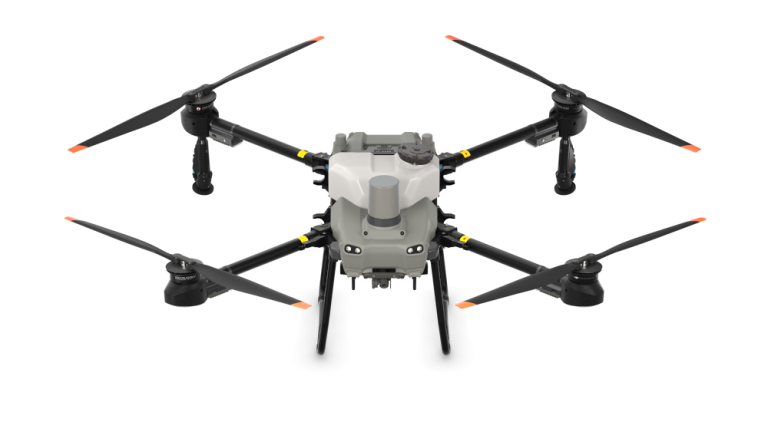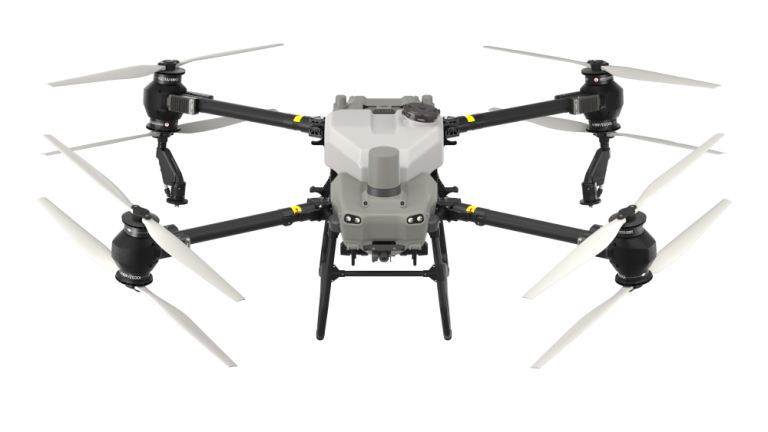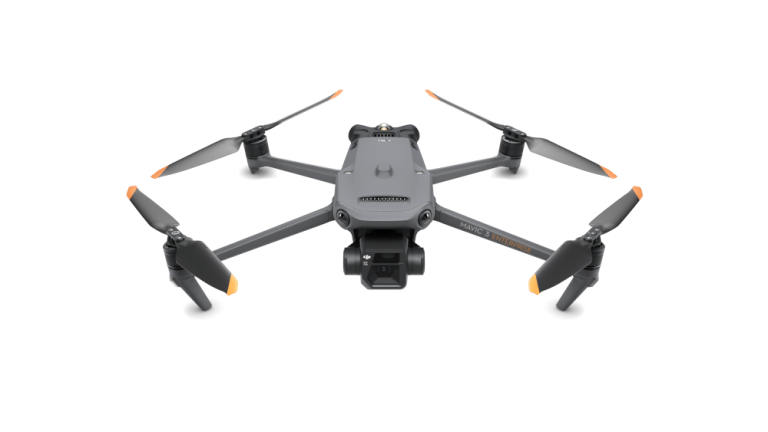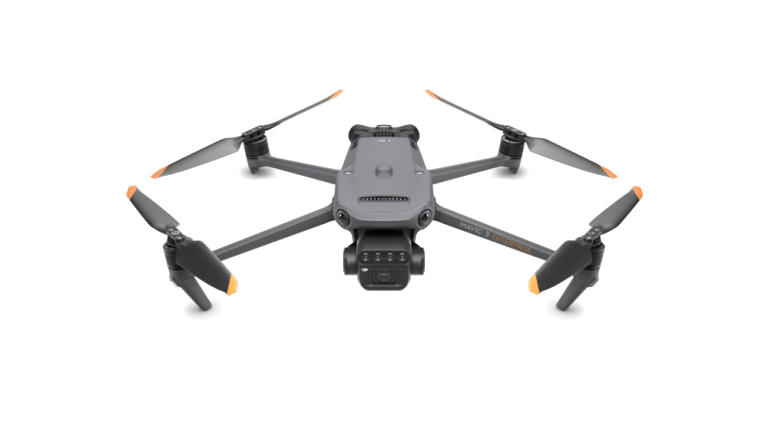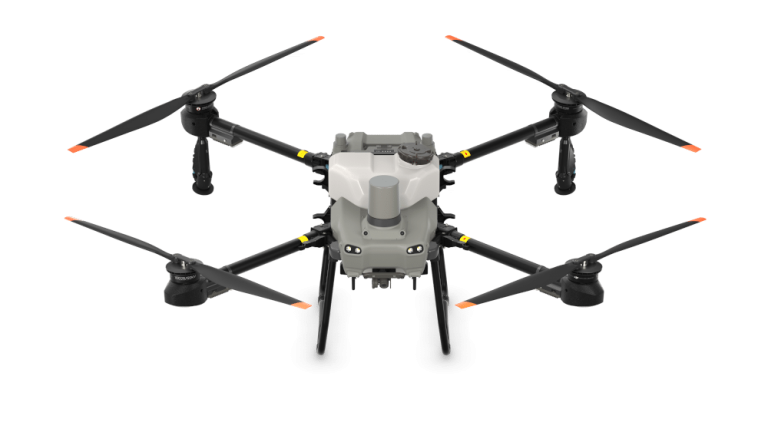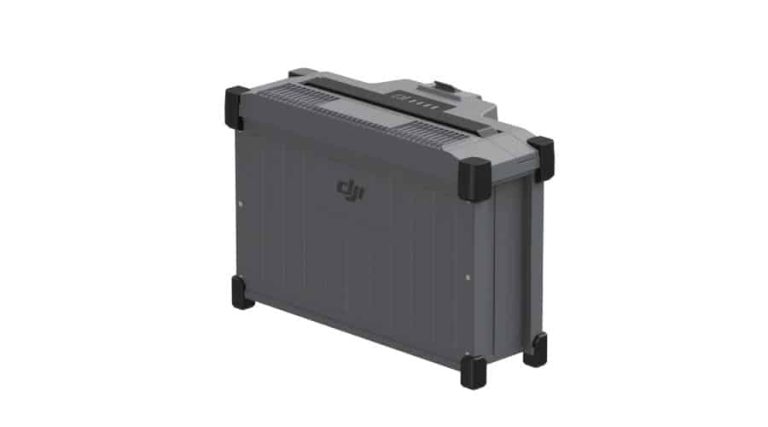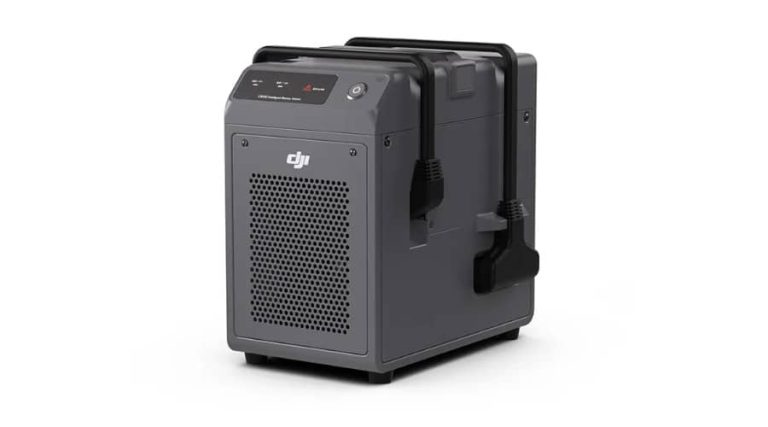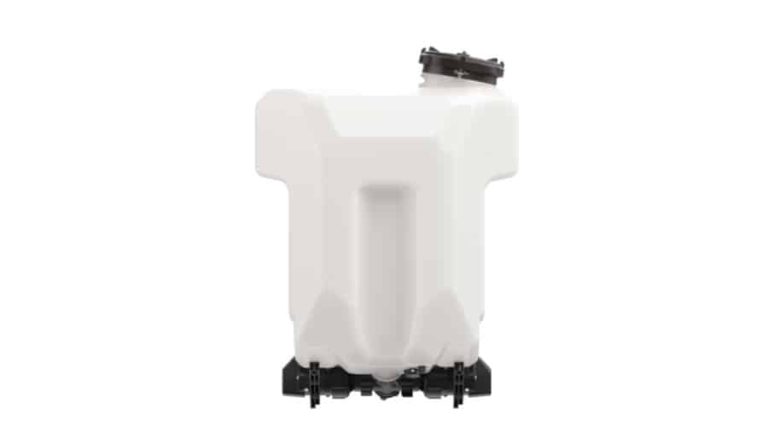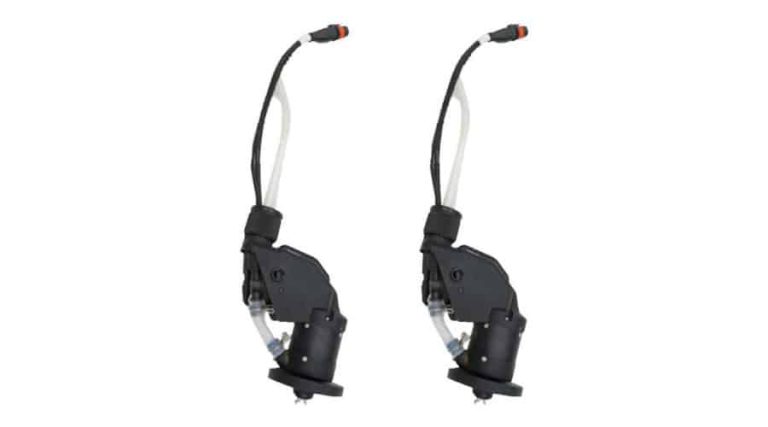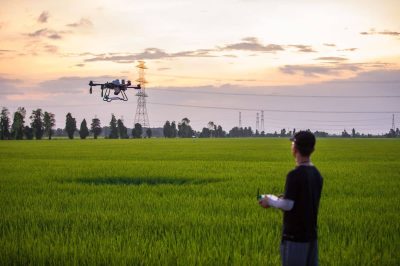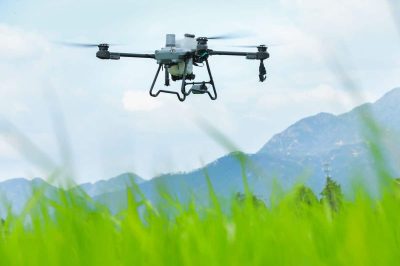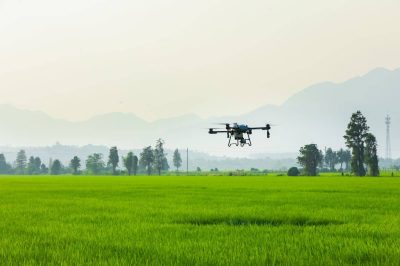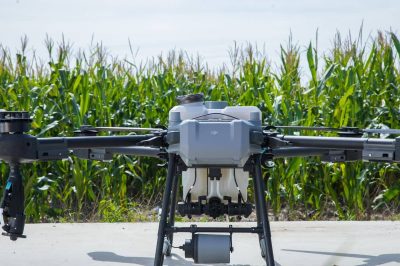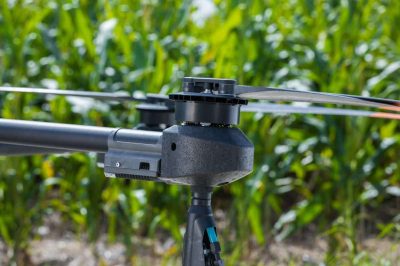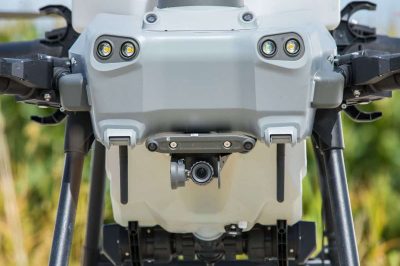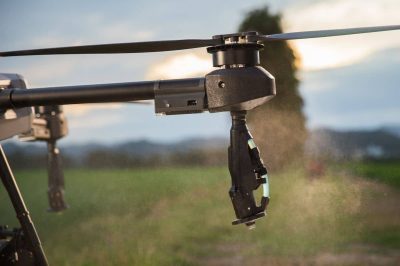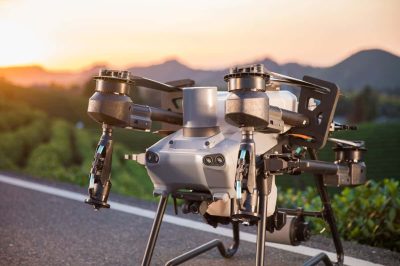The ideal drone even for smaller farms
DJI AGRAS T25 spraying drone
The Agras 25 redefines standards for compact agricultural drones. Light and nimble, T25 can easily be handled by one person. It can carry a spraying
payload up to 20 kg[2] or a spreading payload up to 25 kg[2]. T25 is equipped with Front and Rear Phased Array Radar, a Binocular Vision System, and a high
resolution FPV gimbal camera. T25 supports multiple missions, from surveying[1] and mapping, to spraying and spreading and excels across a variety of
terrains.
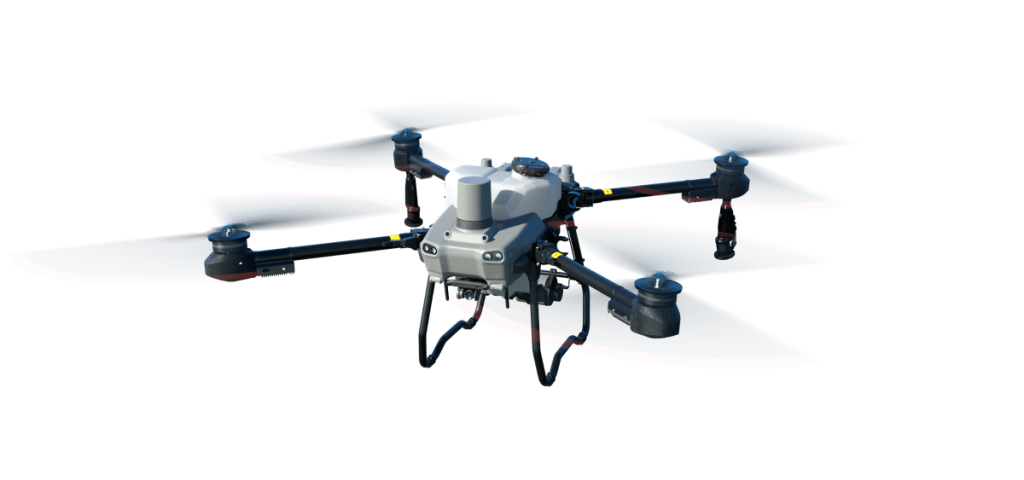
Light and Nimble
Foldable and simple for solo operation
Small for easy takeoff and landing
High Flow Rate
20 kg Spraying[2], 16 L/min[3]
25 kg Spreading[2], 72 kg/min[4]
Signal Stability
Offline operations
2 km O3 Transmission[5]
Optional DJI Relay
All Scenario Adaptability
Fully automatic and manual operation
Orchard Mode
Variable Rate Application
Multidirectional Obstacle Sensing[6]
Többirányú akadályelkerülés,
Domborzatkövetés 50°-os lejtőkig
Four Sprinkler Kit (Optional)
Reverse Directional Spray During Flight
4-sprinkler spraying, flow rate 24 L/min[3]
[1] Data was measured at sea level. The payload weight is greatly affected by the ambient temperature and altitude. The take-off payload weight needs to be reduced by 5 kg for every 1,000 m increase in altitude. The DJI Agras app will recommend the payload weight according to the current status and surroundings of the aircraft. When adding materials, the maximum weight should not exceed the recommended value, otherwise flight safety may be compromised.
[2] RTK is required.
[3] Maximum spraying flow rate with two sprinklers is 16 L/min. Maximum spraying flow rate with four sprinklers is 24 L/min.
[4] Data measured with 4 mm diameter urea. The maximum flow rate may vary depending on the granule size, density, and surface smoothness of different fertilizers.
[5] It was measured at a flight altitude of 2.5 meters, without obstruction or electromagnetic interference.
[6] The effective sensing range and its ability to avoid and bypass obstacles will vary depending on the ambient light, rain, fog, and the material, position, shape, and other properties of the obstacles. Downward sensing
is used for Terrain Follow and Altitude Stabilization. The sensing in other directions is used for Obstacle Avoidance.
[7] Size comparison between the unfolded T25 and the unfolded T20P.
[8] Obstacle Bypassing is supported in the forward direction. The Terrain Follow and Obstacle Bypassing features are not supported at night or in low light environments. Fly with caution. Obstacle Bypassing is not
recommended around electric or guy wires.
[9] Refers to the mapping time after completing the aerial survey. Time varies depending on the firmware version, type of aerial survey, and other factors.
[10] To ensure a high success rate of surveying and mapping, T25 can automatically adjust its flight speed based on the hill slope. The steeper the slope, the slower its speed.
[11] Charging from 30% to 95% with D6000i generator or C8000 Intelligent Battery. Factors impacting charging time: Altitude of the charging station; Charging cable meets requirements for fast charging; Battery cell’s
temperature is in the range of 15° to 70° C (59° to 158° F).
[12] Batteries are covered by warranty for up to 1,500 charging cycles or 12 months, whichever ends first.
Why choose the DJI AGRAS T25 spraying drone?
DJI AGRAS T25 spraying drone
Benefits and features
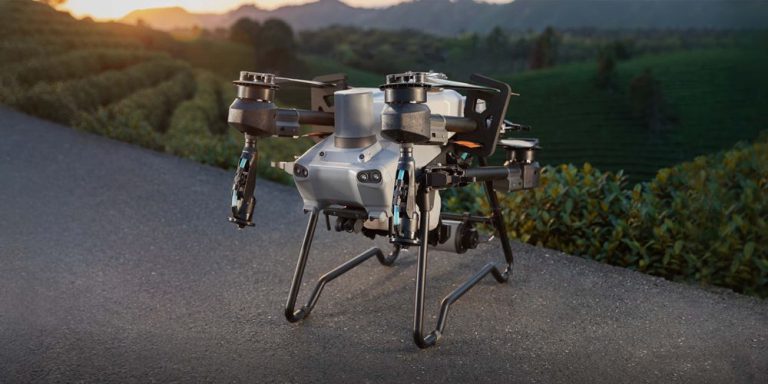
Foldable, Flexible, Functional
- Optimized for solo operations
- Unfolded footprint reduced by 21%[7]
- Four sprinkler turn-free manual flight
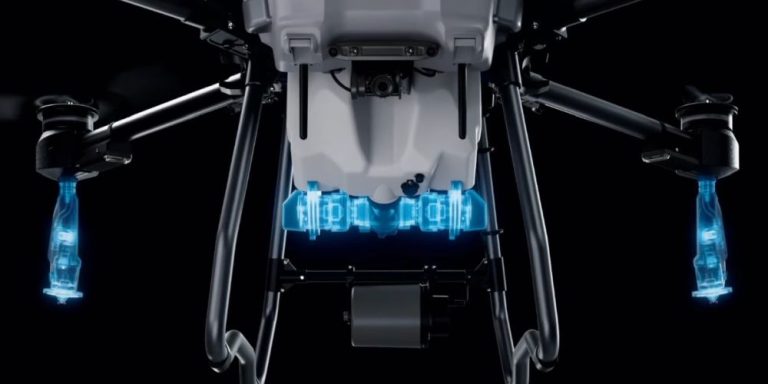
High Rate, Atomized Spray, Leak Free
- Magnetic Drive Impeller Pump, Dual Pump Flow Rate of up to 24 L/min[3]
- Dual Atomizing Centrifugal Sprinklers, Adjustable Droplet Size
- Brand-New Solenoid Valves, Leak Free
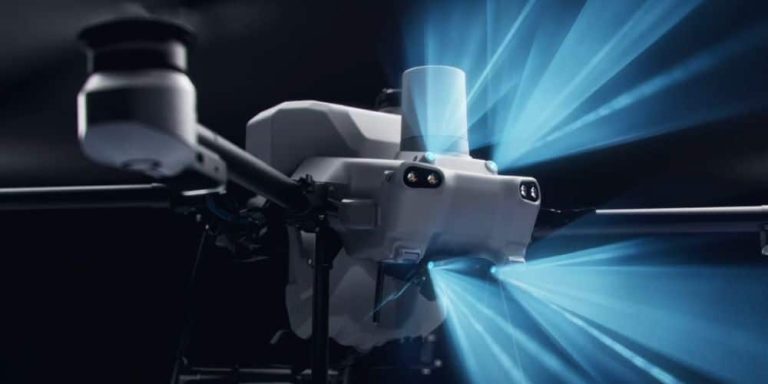
Double Peace of Mind with Binocular Vision and Dual Radar
- Front and Rear Active Phased Array Radars
- Two Sets of Binocular Vision Sensors
- Multidirectional Obstacle Sensing and Avoidance[6]
- Terrain Following up to 50°, Automatic Obstacle Bypassing[8]
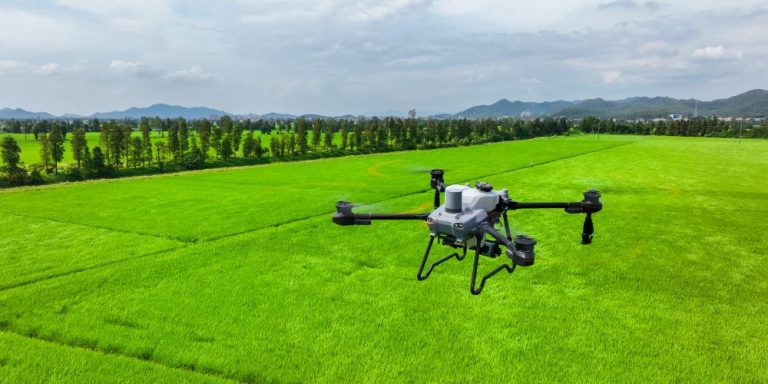
One Drone for Surveying,
Spraying, and Spreading
- High Resolution FPV Gimbal Camera
- The angle of the gimbal is adjustable and images can be collected in real time.
- Orchard Aerial Survey, 5 hectare orchard mapped in 10 minutes[9]
- Field Aerial Survey, 13 hectare field mapped in 10 minutes[9]
- Surveying of slopes up to 20°[10]
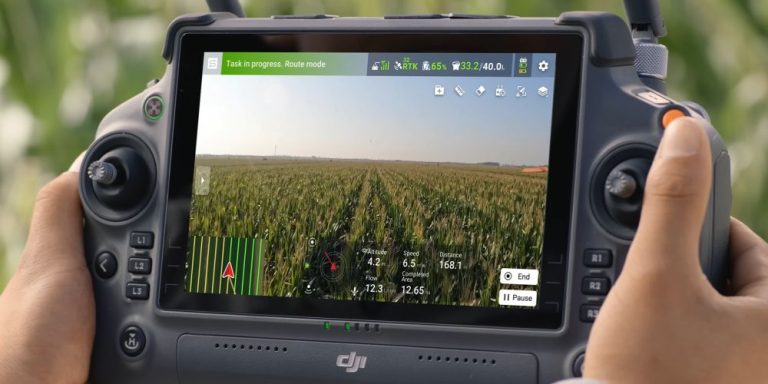
DJI RC Plus
- Quad-antenna O3 Transmission, up to 2 km range[5]
- 7-inch high brightness screen
- 8 core processor for smooth operations
- Optional DJI Relay Module

Fuel-Efficient Fast Charging
- 9-min ultra-fast charging[11]
- Supports 1,500 W AC Output
- Warranty covers 1,500 battery charge cycles[12]
- Fuel & Utility Power Flexibility
DJI AGRAS T25 drone and its accessories
DJI AGRAS T25 spraying drone prices
The DJI AGRAS T25 offers an extremely compact yet powerful air solution for spraying agricultural areas of all sizes and needs. You have the opportunity to monitor field patrols by drone and the state of the crops through artificial intelligence. You can create maps in the cloud for visual management of the parcels. With variable-rate spraying and spreading, we can achieve greater yields and lower operating costs.
More you might be interested in about the DJI AGRAS T25 drone
DJI AGRAS T25 – Featured specifications
| Aircraft weight | 25.4 kg (excl. battery), 32 kg (incl. battery) |
|---|---|
| Aircraft Max Takeoff Weight[1] | Max takeoff weight for spraying: 52 kg (at sea level), Max takeoff weight for spreading: 58 kg (at sea level) |
| Aircraft Max Diagonal Wheelbase | 1925 mm |
| Aircraft Dimensions | 2585×2675×780 mm (arms and propellers unfolded), 1475×1540×780 mm (arms unfolded and propellers folded), 1050×690×820 mm (arms and propellers folded) |
| Aircraft Hovering Accuracy Range (with strong GNSS signal) | RTK enabled: Horizontal: ±10 cm, Vertical: ±10 cm, RTK disabled: Horizontal: ±60 cm, Vertical: ±30 cm (radar module enabled: ±10 cm) |
| Aircraft RTK/GNSSOperating Frequency | RTK: GPS L1/L2, GLONASS F1/F2, BeiDou B1I/B2I/B3I, Galileo E1/E5b, QZSS L1/L2, GNS: GPS L1, GLONASS F1, BeiDou B1I, Galileo E1, QZSS L1 |
| Aircraft Max Configurable Flight Radius | 2000 m |
| Aircraft Max Wind Resistance | 6 m/s |
| Propulsion System - Motors Stator Size | 100x28 mm |
| Propulsion System - Motors KV | 59 rpm/V |
| Propulsion System - Motors Power | 4600 W/rotor |
| Propulsion System - Propellers Material | Nylon carbon fiber filament |
| Propulsion System - Propellers Dimension | 50 inch |
| Propulsion System - Propellers Rotation Diameter | 1270 mm |
| Propulsion System - Propellers Quantity | 4 |
| Dual Atomizing Spraying System - Spray Tank Material | Plastic (HDPE) |
| Dual Atomizing Spraying System - Spray Tank Volume | 20 L |
| Dual Atomizing Spraying System - Spray Tank Operating Payload [1] | 20 kg [1] |
| Dual Atomizing Spraying System - Spray Tank Quantity | 1 |
| Dual Atomizing Spraying System - Sprinklers Model | LX8060SZ |
| Dual Atomizing Spraying System - Sprinklers Quantity | 2 |
| Dual Atomizing Spraying System - Sprinklers Nozzle Distance | 1368 mm(Rear Nozzles) |
| Dual Atomizing Spraying System - Sprinklers Droplet Size | 50-500 μm |
| Dual Atomizing Spraying System - Sprinklers Effective Spray Width [2] | 4-7 m (at a height of 3 m above the crops) |
| Dual Atomizing Spraying System - Delivery Pumps Type | Impreller pump (magnetic drive) |
| Dual Atomizing Spraying System - Delivery Pumps Quantity | 2 |
| Dual Atomizing Spraying System - Delivery Pumps Single Pump Flow Rate | 0-12 L/min |
| Dual Atomizing Spraying System - Delivery Pumps Max Flow Rate | 16 L/min (2 sprinklers); 24 L/min (4 sprinklers) |
| T50 Spreading System Compatible Material Diameter | 0.5-5 mm dry granules |
| T50 Spreading System Spread Tank Volume | 35 L |
| T50 Spreading System Spread Tank Internal Load [10] | 25 kg |
| T50 Spreading System Effective Spread Width | Varies according to material diameter, spinner disk rotational speed, hopper outlet size, and flight altitude. For optimal performance, it is recommended to adjust the corresponding variables to achieve a spreading range of 5-8 meters. |
| Phased Array Radar System Model | RD241608RF (forward phased array radar); RD241608RB (rear phased array radar) |
| Phased Array Radar System Terrain Follow | Max slope in mapping-free operation: 50°, Altitude detection range: 1-50 m, Stabilization working range: 1.5-30 m |
| Phased Array Radar System Obstacle Avoidance [4] | Obstacle sensing range (multidirectional): 1-50 m, FOV: Forward phased array radar: horizontal 360°, vertical ±45°, upward ±45° (cone), Rear phased array radar: vertical 360°, horizontal ±45°, Working conditions: flying higher than 1.5 m over the obstacle at a horizontal speed no more than 10 m/s and vertical speed no more than 3 m/s, Safety limit distance: 2.5 m (distance between the front of propellers and the obstacle after braking), Sensing direction: 360° multidirectional sensing |
| Binocular Vision System Measurement range | 0.5-29 m |
| Binocular Vision System Effective Sensing Speed | ≤10 m/s |
| Binocular Vision System FOV | Horizontal: 90°, Vertical: 106° |
| Binocular Vision System Operating Environment | Adequate light and discernible surroundings |
| Remote Controller Model | RM700B |
| Remote Controller Operating Frequency [5] | 2.4000-2.4835 GHz, 5.725-5.850 GHz |
| Remote Controller Max Transmission Distance | 7 km (FCC), 5 km (SRRC), 4 km (MIC/CE); (unobstructed, free of interference, and at an altitude of 2.5 m) |
| Remote Controller Wi-Fi Protocol | Wi-Fi 6 |
| Remote Controller Wi-Fi Operating Frequency [5] | 2.4000-2.4835 GHz, 5.150-5.250 GHz, 5.725-5.850 GHz |
| Remote Controller Bluetooth Protocol | Bluetooth 5.1 |
| Remote Controller Bluetooth Operating Frequency | 2.4000-2.4835 GHz |
| Remote Controller GNSS | GPS+Galileo+BeiDou |
| Remote Controller Screen | 7.02-in LCD touchscreen, with a resolution of 1920×1200 pixels, and high brightness of 1200 cd/m2 |
| Remote Controller Operating Temperature | -20° to 50° C (-4° to 122° F) |
| Remote Controller Storage Temperature Range | Less than one month: -30° to 45° C (-22° to 113° F), One to three months: -30° to 35° C (-22° to 95° F), Six months to one year: -30° to 30° C (-22° to 86° F) |
| Remote Controller Charging Temperature | 5° to 40° C (41° to 104° F) |
| Remote Controller Internal Battery Runtime | 3 hours 18 minutes |
| Remote Controller External Battery Runtime | 2 hours 42 minutes |
| Remote Controller Charging Type | It is recommended to use a locally certified USB-C charger at a maximum rated power of 65 W and maximum voltage of 20 V such as the DJI 65W Portable Charger. |
| Remote Controller Charging Time | 2 hours for internal battery or internal and external battery (when remote controller is powered off and using a standard DJI charger) |
| DB800 Intelligent Flight Battery Model | DB800 Intelligent Flight Battery (BAX702-15500mAh-52.22V) |
| DB800 Intelligent Flight Battery Weight | Approx. 6.6 kg |
| DB800 Intelligent Flight Battery Capacity | 15500 mAh |
| DB800 Intelligent Flight Battery Nominal Voltage | 52.22 V |
| D6000i Multifunctional Inverter Generator Output Channel | 1. DC charging output 42-59.92V/4500W, 2.AC output 230V/1500W or 120V/750W[8] |
| D6000i Multifunctional Inverter Generator Battery Charging Time[11] | To fully charge one battery (DB800 battery) takes 9-12 mins |
| D6000i Multifunctional Inverter Generator Fuel Tank Capacity | 20 L |
| D6000i Multifunctional Inverter Generator Starting Method | Starting the Generator via the One-Button Start Switch |
| D6000i Multifunctional Inverter Generator Max Power of Engine | 6000 W |
| D6000i Multifunctional Inverter Generator Fuel Type | Unleaded gasoline with RON ≥91 (AKI ≥87) and alcohol content less than 10%, (*Brazil: unleaded gasoline with RON ≥ 91 and alcohol content of 27%) |
| D6000i Multifunctional Inverter Generator Reference Fuel Consumption [9] | 600 ml/kWh |
| D6000i Multifunctional Inverter Generator Engine Oil Model | SJ 10W-40 |
| C8000 Intelligent Power Supply Model Number | CHX101-7000 |
| C8000 Intelligent Power Supply Dimensions | 300 × 280 × 230 mm |
| C8000 Intelligent Power Supply Weight | Approx. 11.5 kg |
| C8000 Intelligent Power Supply Input/Output | Input Voltage: 100-240 VAC, Output Voltage: 59.92V, Output Current: 100A max |
| C8000 Intelligent Power Supply Charging Time [11] | Fully charges a battery in 9 to 12 minutes (DB800 Intelligent Flight Battery) |
| C8000 Intelligent Power Supply Protection Functions | Over-voltage, over-charge, under-voltage and over-temperature protection. |
| C8000 Intelligent Power Supply Charging Safety | AC wire protection, power wire protection, and charge connector protection |
| Relay Model | RL01-65 |
| Relay Dimensions | 120×110×100 mm |
| Relay Weight | ≤575 g |
| Relay Input Voltage [6] | 9 V3 A / 12 V2.5 A / 15 V2 A |
| Relay Power Consumption | 9 W (SRRC), 12 W (FCC) |
| Relay Capacity | 6500 mAh |
| Relay Operating Time | 4 hours |
| Relay Operating Frequency [5] | 2.4000-2.4835 GHz, 5.725-5.850 GHz |
| Relay Max Transmission Distance | 5 km (SRRC), 4 km (MIC/KCC/CE), 7 km (FCC), (unobstructed, free of interference, and at a flight altitude of 2.5 m) |
| Relay Charging Time | 2 hours and 20 minutes (when using a standard DJI charger) |
| Relay IP Rating [6] | IP55 |
| Definition | [1] Data was measured at sea level. The payload weight is greatly affected by the ambient temperature and altitude. The payload weight needs to be reduced by 10 kg for every 1,000m increase in altitude. The DJI Agras app will recommend the payload weight according to the current status and surroundings of the aircraft. When adding materials, the maximum weight should not exceed the recommended value, otherwise flight safety may be compromised., [2] The spray width of the spraying system depends on the operating scenario and demand for coverage evenness., [3] The spread width of the spreading system depends on the operating scenario and demand for coverage evenness., [4] The effective sensing range and its ability to avoid and bypass obstacles will vary depending on the ambient light, rain, fog, and the material, position, shape, and other properties of the obstacles. Downward sensing mainly assists in Terrain Follow and Altitude Hold. The sensing in other directions is used for Obstacle Avoidance., [5] 5.8 GHz frequency is unavailable in some contries. Check local regulations for more information., [6] Use chargers or external power supplies that meet the specifications. Otherwise, the device may not work normally., [7] The protection rating may be reduced due to improper use and damage caused by external forces or environmental factors., [8] The actual power and voltage may vary according to local regulations., [9] Measured using RON 92 gasoline at near sea level with an ambient temperature of 25° C, while charging at 9 kW., [10] The DJI Agras app will intelligently recommend the payload weight limit for the spread tank according to the current status and surroundings of the aircraft. DO NOT exceed the recommended payload weight limit when adding material to the spread tank. Otherwise, the flight safety may be affected., [11]Factors impacting charging time: Altitude of the charging station; Charging cable meets requirements for fast charging; Battery cell's temperature is in the range of 15° to 70° C (59° to 158° F) |
The latest news from the world of precision farming
Related News on Agricultural Drones
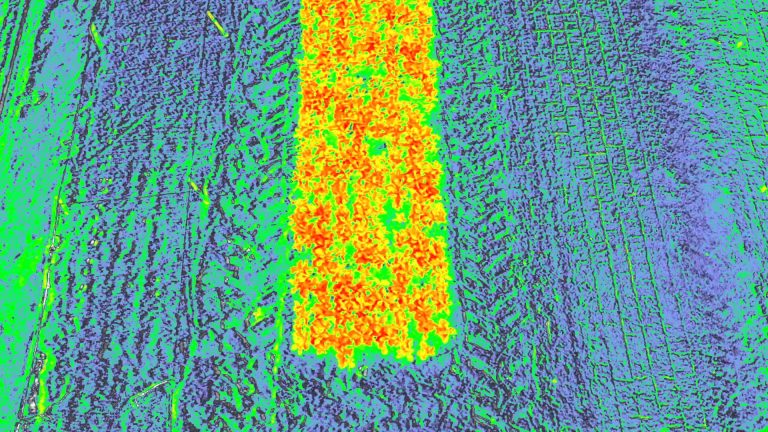
Beyond the visible: Getting crucial insights for pine tree nursery with DJI Mavic 3 Multispectral and Proofminder AI model
When it comes to running a tree nursery, there are a lot of factors to consider in order to maximize efficiency and yield. Direct field observations and timely insights on tree nurseries will always be essential for tree management to:

Taking Agriculture to the Next Level: The DJI Mavic 3
The world’s leading commercial drone manufacturer, DJI, has released the Mavic 3 Multispectral, its latest and most advanced agricultural drone. This agricultural drone, which will be available soon at our distributors, combines multispectral imaging with DJI’s cutting-edge technologies, is a

Agricultural Drone Industry Insight Report (2021)
I. Industry background (I) From “plant protection drones” to “agricultural drones” As early as 1987, Japan developed the world’s first plant protection drone, selling them in limited quantities the following year. Of the nearly 5 million hectares of arable land
